First of three parts
WILMINGTON – As a monstrous Hurricane Florence closed in on North Carolina’s coast, Duke Energy launched its largest-ever mobilization of resources and announced it was taking steps to storm-ready its coal ash basins and cooling ponds in the east, including one just outside the city in the bull’s-eye of the storm.
Supporter Spotlight
Spokespeople for the Charlotte-based energy company rebutted statements made by environmentalists last month who raised concerns about the storm’s potential to breach open ash basins, spilling mucky, gray sludge into nearby waterways.
The company’s ongoing efforts to close its basins by either removing water to cap the ponds or excavate them reduced the flooding threat, Duke Energy officials told news reporters.

“We got a head start on a lot of the industry,” one company spokesperson said to the Los Angeles Times. “We think that positions us well going into the storm.”
Less than a week after Hurricane Florence made landfall Sept. 14 in Wrightsville Beach, the company reported that about 2,000 cubic yards of soil and ash – enough to fill about two-thirds of an Olympic-sized swimming pool – spilled from the landfill at L.V. Sutton Power Station near Wilmington.
After the Category 1 hurricane’s strike, one that dumped around 9 trillion gallons of water on North Carolina over four days, water samples were collected in Sutton Lake and the lower Cape Fear River.
Supporter Spotlight
Duke Energy, the North Carolina Department of Environmental Quality, or DEQ, and environmental activist group Waterkeeper Alliance have all collected samples on various days, in various locations within the river and the lake.
The results have ultimately pitted those of Duke Energy and the state against the Waterkeeper Alliance, equating to a he-said, she-said that has unfolded in daily news reports, leaving readers unsure of where the truth lies.
To get to the answer of how much, if any, environmental harm has been caused by coal ash spilling into the lake and river, sample collectors must literally dig deeper, according to several academic researchers who’ve been studying coal ash for years.
The ‘Real Danger’
Disputing the water sample test results that have been published by the energy company, the state and environmental advocates put the focus solely on whether the levels of ash contaminants in the lake and river exceed government limits.
“It doesn’t tell you whether or not there’s been a large transport or not of coal ash into the river,” said Avner Vengosh, a Duke University professor who specializes in geochemistry and water quality. “That’s the real danger.”

He called the sample test results, “noise playing into the hands of Duke Energy.”
“The likelihood to find anything in a flooding event is very, very low,” Vengosh said. “The ability to measure the coal ash contaminants in river water during flooding is limited because the mobilization of contaminants from coal ash to the water as dissolved constituents would be very small compared to the large volume of the flood water that would dilute any signal. Even if there is some organization of metal, it’s not going to immediately coalesce. It doesn’t tell you whether or not there’s been a large transport or not of coal ash into the river.”
Coal ash is a toxic cocktail, the recipe of which includes mercury, arsenic, lead and chromium – chemicals that can cause cancer, irreversible brain damage and other diseases in people and wildlife when found in high concentrations.
Sediment testing will determine whether coal ash contaminants have settled at the bottom of the Cape Fear River and Sutton Lake, Vengosh said.
His work with a team of researchers in Tennessee following the largest coal-ash spill in history demonstrated that the major problem was not coal ash in the river water – it was coal ash in the river sediments.
The Dec. 22, 2008, catastrophe occurred when a dike failed at the Tennessee Valley Authority’s Kingston Fossil Plant, releasing 5.4 million cubic yards of coal ash into the Emory and Clinch rivers. The release in Roane County, Tennessee, about 30 miles west of Knoxville, also covered about 300 acres outside the coal ash dewatering and storage areas.
As part of the massive, multi-year, billion-dollar cleanup, workers dredged more than 3 million cubic yards of ash from the Emory River.
Less than six years after the TVA spill, a pipe at a coal ash pond at Duke Energy’s retired Dan River Steam Station near Eden, North Carolina, collapsed, dumping up to 39,000 tons of coal ash into the river.
Ash from the Feb. 2, 2014, spill spread as far as 70 miles downstream.
By the spring of 2014, the energy company hired a contractor to vacuum-dredge about 2,500 tons of coal ash sitting on the riverbed of the Dan River.
Duke Energy retrieved about 10 percent of the ash from several deposits by dredging and “similar measures,” according to a February 2015 Greensboro News & Record article.
A year after the Dan River spill, Duke Energy officials referenced scientific surveys that showed evidence the levels of coal ash contamination in the sediment downstream were diminishing based on sediment samples.
But results of one sediment study published last year tell a different story in the Dan River and Vengosh warns against comparing the spills that occurred in Tennessee and the Dan River with the breach last month near Wilmington.
“It’s different than a spill like the one at the Dan River or TVA, which were normal conditions where a huge amount of coal ash was moved in the river system,” he said. “Here we’re talking about flooding, which contained a huge amount of sediment and coal ash. Even in the TVA coal ash spill (without a major flooding event) the open river water quality was only slightly affected as compared to water under restricted flow or water entrapped within the river bottom sediments.”








